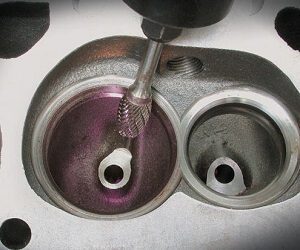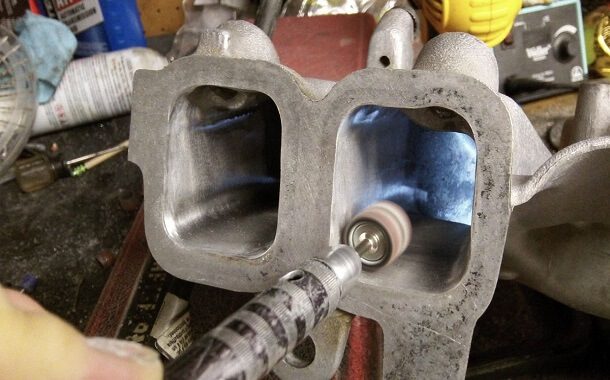Port And Polish Heads Cost
Last Updated on December 11, 2021
Written by CPA Alec Pow | Content Reviewed by ![]() CFA Alexander Popinker
CFA Alexander Popinker
The cylinder head is a significant part of your vehicle’s engine and plays a key role in the internal combustion process. The cylinder head is used to control the intake of air and fuel, as well as the exhaust.
There are a few methods to increase your engine’s airflow, but one of the simplest and most cost-effective is porting and polishing the cylinder heads. Porting involves removing restrictions from an object so that it can permit more airflow through its surface area than before which will result in increased power output because now there’s not as much resistance preventing fuel combustion.
Cleaning your car’s cylinder head is important because deposits on the engine valves increase vehicle fuel consumption, decrease engine performance and create an unbalanced ride.
Most mechanics perform this operation by removing the cylinder head from the car, an operation that involves generating other costs. But there are also mechanics that perform this operation without removing the cylinder head, with the help of a sandblasting device. The fabric used for blasting is one made of fine particles of walnut shell.
How much does it cost to port and polish heads?
The price for porting and polishing heads depends on many factors including the type of the engine and its level of wear, the geographical area, the type of the car, and the type of port and polish needed. However, the costs start at around $220 and can go up to more than $2,200.
There are four stages of port and polish heads you can choose from.
The most basic form of porting and polishing is Stage I and it costs around $160. In this service, you will get a port match, plus a bowl stage and it is the minimum recommended stage.
If you are on a budget you should go for Stage II, also known as “strip” or “street” port job. In this stage, the intake opening port matches, and the bowl will be polished. Expect to pay almost $320 on this.
The best value port and polish you can get is Stage III. This “full port and polish” stage will cost around $560 and includes porting of the bowls, entire profiling of the combustion chambers, and a port match.
Depending on your geographical area, the costs of Stage III port and polish services may vary. In the table below you will find the average cost that you will find in different U.S. locations.
| US Location | Average Cost of
Stage III Port and Polish |
|---|---|
| Florida | $580 |
| New York | $520 |
| Virginia | $470 |
| Michigan | $380 |
| Maine | $370 |
The highest stage of porting and polishing heads is Stage IV. It is a must for high-pressure and nitrous turbocharger or supercharger owners. Besides all the things mentioned above, in this type of service, you will get more precise profiling of the combustion chambers, a fully ported exhaust, a port match intake, and the bowl ported. Expect to pay around $780 for this type of service.
When talking about porting and polishing heads we must take into consideration the labor costs as well. Most of the mechanics will charge anywhere between $90 and $130 per hour.
You might also like our articles about the cost of rocker panels and cab corners replacement, 6.0 Powerstroke rebuild, or power steering belt replacement.
It is important to also consider the cost to port a manifold as every cylinder has an intake manifold that must be ported too. This job includes plenum blending and port matching and costs around $260.
Port and polish heads details
The cylinder head is an engine component that is mounted on the top of the engine block, above the cylinders and its role is to “close” the combustion chamber. There are “whole” cylinder heads that are made in one piece, common, and cover all cylinders or it can be “individual” meaning to be a small cylinder head for each cylinder.
Or there may be 2 cylinder heads, grouped for multiple cylinders (this is for V-cylinder engines, where there are usually 2 cylinder heads). The cylinder head together with the engine block and the piston comprise the combustion chamber.
The cylinder head is a very complex component of the engine and has a contorted shape because it is multi-functional. This is because it contains a part of the distribution system (i.e. valves, valve springs, camshafts, rocker arms, dowels), injectors, and glow plugs.
Most of the time these cylinder heads are made of cast iron or cast aluminum alloys. However, the cylinder head must meet a lot of requirements. For example, they must have a very high mechanical rigidity, high thermal resistance, and they should perfectly seal the coolant, the intake/exhaust gases, and the oil.
What are the extra costs?
In case you want to port and polish the cylinder head yourself you must take into consideration that you will need some tools. The most important is the Dremel with the right extensions and bits.
Also, you will have to invest in stone bits and carbide so you can grind away all the casting lines and burs.
Seeing that during the grinding phase the metal turns into a fine powder, you will need some Personal Projection Equipment to protect your eyes and lungs.
Besides these, you will need all the necessary tools to remove the cylinder head and the components attached to it. So, you must have a spring compressor, plus other special tools.
Important things to consider
 A cylinder head upgrade seems like a good investment when you consider the fact that porting and polishing can increase the engine horsepower by 10 to 75, depending on the engine’s setup and other upgrades you may have.
A cylinder head upgrade seems like a good investment when you consider the fact that porting and polishing can increase the engine horsepower by 10 to 75, depending on the engine’s setup and other upgrades you may have.
Porting a vehicle’s cylinder head consists of an engine modification that will increase its performance for sure. The process of porting involves “cleaning up” the intake and exhaust valves with special tools, so they can operate more efficiently due to increased airflow at higher speeds in order to create power without infringing on factory parameters, while still maintaining good fuel economy.
When porting and polishing the cylinder heads everything connected to them must first be disconnected. These include fuel rails, ignition cables, air hoses, sensor wires and some more. The job itself involves scrubbing the mating areas very well.
The cleaning process involves:
- Removal of old sealant from threads, gaskets or sealant.
- Clean all cylinder head surfaces with a non-corrosive solvent.
- Purge all galleries for compressed air oil.
- Removal of any carbon deposits from the combustion chamber.
- Clean all deposits or layers formed on the depths of the lifting device.
You might be surprised to learn that porting and polishing a cylinder head isn’t always about making it bigger. The car engine will be able to burn more fuel and reach higher speeds if it can take in more air.


Leave a Reply
Want to join the discussion?Feel free to contribute!